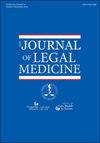COVID-19 and Firearms: Public Health Considerations
IF 0.8
4区 医学
Q3 LAW
引用次数: 0
Abstract
COVID-19 and Firearms: Public Health Considerations Emily M. Silver, MA; esilver3@uchicago.edu Department of Psychology Integrative Neuroscience Program, The University of Chicago, IL The global SARS-CoV-2 (otherwise known as COVID-19) pandemic has wreaked havoc across the world, infected over 100 million people and resulted in the deaths of approximately 2 million people to date (1). The need for people to remain physically separated from one another to reduce the spread of disease has resulted in many public health, corporate, and government policy changes. One particularly troubling phenomenon has been the increase in the rates of deaths by firearm violence in the US in 2020 (2). The evolving literature has documented increases across a number of inter-related issues including mental health conditions (3), suicide rates (4), violence (5), and firearm purchases (6). It is of paramount importance to recognize these trends and discuss the implications regarding short-term and long-term effects as well as how they may affect the delivery of health services. Pandemic-related Increases: Firearms Firearms have been purchased at historic rates during the pandemic (Mannix et al). Firearm sales in March 2020 increased by 85% from the previous year (7), resulting in an estimated 2.1 million excess firearm sales (6). The recent surge in firearm purchases is likely linked at least in part to the pandemic, which has induced heightened states of uncertainty and anxiety. The pandemic is associated with increased worry about violence, both for oneself and others, as well as increased firearm acquisition and changes in practices related to storage of firearms, including unlocked storage (8,9). Intent to purchase a firearm in the next twelve months is associated with more severe anxiety specific to COVID-19 (10). Therefore, not only are sales of firearms increasing, but people may be buying them in reaction to fears resulting from the pandemic. Pandemic-related Increases: Mental Health Conditions Measures intended to limit the spread of the virus, such as city-wide lockdowns and social distancing policies, have also induced pervasive psychological distress (11). Social isolation and loneliness, known risk factors for depression 2021 American College of Legal Medicine JOURNAL OF LEGAL MEDICINE 2021, VOL. 41, NO. S1, 42–46 https://doi.org/10.1080/01947648.2021.1914491 and feelings of hopelessness, likely contribute to the prevalence of anxiety and depression (12). An analysis of depressive symptomology in the US found a 3fold increase during the COVID-19 pandemic as compared to before (13). The pandemic has also been associated with disruptions in sleep (11,14), substance abuse (11,15), and posttraumatic stress (16,17). Frontline health workers are at particular risk for an increase in anxiety and depression (18). Pandemic-related Increases: Suicide Increases in prevalence of psychopathology and mental health crises during the pandemic has brought on concerns about increased suicide risk. Suicide risk is associated with a number of factors, including unemployment and related stressors, access to firearms, interpersonal violence, and substance abuse (19), all of which have been associated with the COVID-19 pandemic. Indeed, analysis of internet searches finds a surge in searches of psychological needs related to suicide in 2020 as compared to 2019 (20). Concerns about a suicide epidemic following the pandemic may be related to the increased access to firearms. The presence of a firearm in the home is a known risk for death by suicide with a gun (21). Physicians may be especially at-risk for suicide during the pandemic as they experience high levels of stress and burnout. Furthermore, intent to purchase a firearm in 2020 was associated with both suicidal ideation in the past year and working as an essential worker during the COVID-19 pandemic (10). Pandemic-related Increases: Violence Overall, crime in the United States appears to have declined following the start of the pandemic (5). However, rates of serious crimes, including interpersonal violence (IPV), serious battery, and homicide have either remained stable or increased (5). Early findings indicate firearm-related violence is on the rise as well (22,23). Shelter-in-place and lockdown measures have also created conditions for violence to perpetuate within the home, making IPV a critical issue during this time (24). Indeed, emerging evidence from around the globe has shown increased domestic violence rates worldwide (25). In the United States women and children may be particularly vulnerable to increased violence during this time. Search terms related to femicide increased significantly from 2019 to 2020 (19), and while reports of child abuse have decreased (26,27) hospitalizations for child abuse and neglect have remained the same (28). Federal Gun Regulations in the Context of the Pandemic Despite the widespread belief that a mental health diagnosis, counseling, or even medication for a mental health condition disqualifies an individual JOURNAL OF LEGAL MEDICINE 432019冠状病毒病与枪支:公共卫生考虑
尽管人们普遍认为,精神健康诊断、咨询,甚至是针对精神健康状况的药物治疗,都使个人丧失了行医资格
本文章由计算机程序翻译,如有差异,请以英文原文为准。
求助全文
约1分钟内获得全文
求助全文
来源期刊

Journal of Legal Medicine
Multiple-
CiteScore
1.10
自引率
0.00%
发文量
3
期刊介绍:
The Journal of Legal Medicine is the official quarterly publication of the American College of Legal Medicine (ACLM). Incorporated in 1960, the ACLM has among its objectives the fostering and encouragement of research and study in the field of legal medicine. The Journal of Legal Medicine is internationally circulated and includes articles and commentaries on topics of interest in legal medicine, health law and policy, professional liability, hospital law, food and drug law, medical legal research and education, the history of legal medicine, and a broad range of other related topics. Book review essays, featuring leading contributions to the field, are included in each issue.
 求助内容:
求助内容: 应助结果提醒方式:
应助结果提醒方式:


